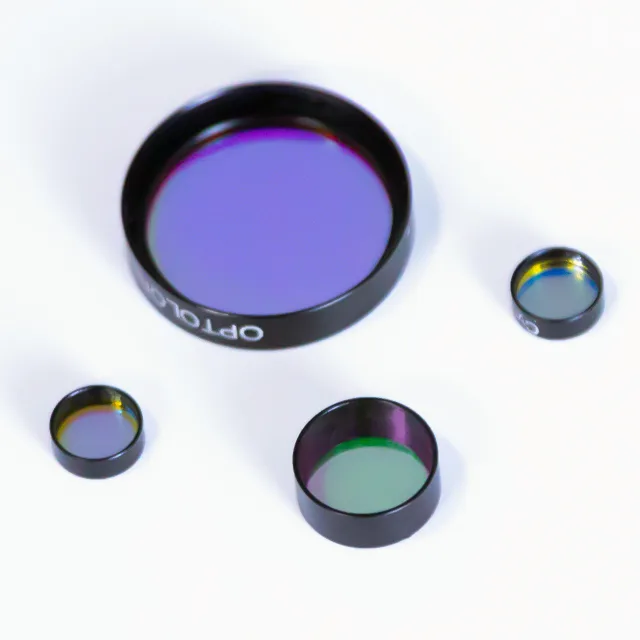Bandpass filters help isolate spectral features, reduce noise, and focus on specific aspects of the spectrum. This introduction will explore the basic working principles, practical applications, and some common problems of bandpass filters in the field of optics.
What is a Band Pass Filter?

In optics, a bandpass filter selectively passes light within a specific range of wavelengths and blocks light at other wavelengths. This filter has a wide range of applications in spectral analysis, communication systems, and imaging applications
How the bandpass filter works
An optical bandpass filter is a special optical device that allows light within a specific wavelength range to pass while blocking light at other wavelengths. Such filters are important in a variety of scientific and industrial applications, such as spectroscopy, imaging technology, and laser systems. Here’s how a bandpass filter works:
Selective absorption: Substrate glass is highly absorbent to certain wavelengths of light, while allowing other wavelengths of light to pass through. For example, red glass absorbs blue-green light and transmits red light. Absorptive filters rely on the absorption of the material itself.
Interference principle: Bandpass filters can use the interference principle of light waves to achieve their functions.These thin film layers are designed so that light of the required wavelengths constructively interferes between the layers and passes through the filter, while light of other wavelengths interferes destructively and is filtered out. interference optical filters dependent on reflection from multiple layers of thin film , so it can be customized with ultra narrow bandwidths (such as ±3nm), but are sensitive for angular.
Application areas: In practical applications, bandpass filters are used to enhance image quality, separate spectral lines, and protect sensitive equipment from harmful wavelengths of light.
How to use optical bandpass filters?

Using optical bandpass filters primarily involves selecting the appropriate filter and installing it correctly into the optical system. Here are some basic steps and considerations:
Determine your needs: First determine the wavelength range of light you need to filter or pass. This will help you choose a bandpass filter with the correct light transmission window.
Consider filter type: Depending on your specific application, choose the appropriate filter material and type, such as an interference or absorptive bandpass filter.
Check compatibility: Make sure the filter is compatible with your optical equipment, such as the appropriate size and mounting interface for the equipment.
Correct installation: Correctly install the filter in the optical path of 0° or 45°, ensure that the filter is parallel to the propagation direction of the beam, and there is no tilt or offset, which can minimize reflection and interference phenomena and ensure that the light propagation is smooth. affected to ensure system performance and accuracy.
Fine Tuning: After installation, fine tuning of the system may be required to ensure maximum light efficiency and optimal filtering. Make sure the filter is perfectly aligned with the light source and detector.
Performance Testing: After installation is complete, tests are performed to verify that the filter is working as expected, i.e., correctly blocking or passing specific wavelengths of light.
Adjust parameters: Based on the test results, adjust the light source or other system parameters to optimize the performance of the entire device.
Regular maintenance: Check and clean your filter regularly to maintain its performance and extend its service life. Avoid fingerprints and dust accumulation, which may affect the filtering effect.
By following the above steps, you can effectively use optical bandpass filters to control and improve the performance of your optical systems, whether in scientific research in the laboratory or in industrial applications.
Applications of Band Pass Filters in Optical Devices
In the realm of optical devices, band pass filters are utilized in diverse applications such as laser systems, hyperspectral imaging, and remote sensing. In laser systems, band pass filters are employed to isolate specific wavelengths for various medical and industrial procedures.
Hyperspectral imaging relies on band pass filters to capture detailed spectral information for applications in agriculture, environmental monitoring, and food safety.
And the band pass filters can be found in everyday consumer electronics like digital cameras and smartphone cameras. These devices use band pass filters to capture and process light within specific wavelength ranges, resulting in high-quality images with accurate color representation.
Furthermore, band pass filters are integral components in optical sensors used for detecting and analyzing various substances based on their unique spectral signatures.
We also explained in detail in our previous article What are the uses of bandpass filters in optics? , you are welcome to check it at any time.
What is the difference between bandpass filters and multi-bandpass filters?
Bandpass filters and multi-bandpass filters are functionally similar, but have some key differences, as follows:
Bandpass filter: This type of filter allows only a specific narrow range of wavelengths to pass through while blocking all other wavelengths of light. It is used specifically for applications requiring light sources of specific wavelengths, such as certain spectral analysis and medical imaging techniques.
Multi-bandpass filter: This filter allows multiple different wavelength ranges to pass through at the same time. It is suitable for situations where multiple wavelengths need to be observed or processed simultaneously, such as in multi-color fluorescence microscopes or complex optical systems. Multiple signals can be processed through one filter to simplify system design.
Conclusion
In summary, a bandpass filter in optics is a critical component that selectively allows a specific range of wavelengths to pass while blocking other wavelengths outside that range.
They improve the performance and functionality of optical systems by fine-tuning transmission and blocking capabilities.
By then, if you want to learn more about the bandpass filter or purchase it, please feel free to contact us and we will help you solve some of your doubts.
FAQ
What are the key characteristics of band pass filters in optics?
Band pass filters in optics are characterized by their ability to selectively transmit light within a specific range of wavelengths while blocking out unwanted wavelength.
They operate based on the principles of interference, utilizing constructive and destructive interference to allow certain wavelengths to pass through. Additionally, band pass filters can be designed with varying bandwidths and center wavelength to cater to different applications in optical systems.
How do band pass filters differ from other types of optical filters?
Unlike other types of optical filters, such as low-pass or high-pass filters, bandpass filters specialize in transmitting a narrow or wide range of wavelengths. This unique property allows them to isolate and analyze specific spectral information.
What are the practical benefits of using band pass filters in optical devices?
The use of band pass filters in optical devices offers several practical benefits, including enhanced spectral resolution, improved signal-to-noise ratio, and precise isolation of desired wavelengths.
How can one determine the appropriate band pass filter for a specific application?
Determining the appropriate bandpass filter requires consideration of several factors, including the desired wavelength range, bandwidth requirements, and environmental conditions. In addition, the installation angle of the filter (such as 0° or 45°) may also affect its performance, so this factor needs to be taken into consideration when selecting.
Related reading: What is the optical filter?
